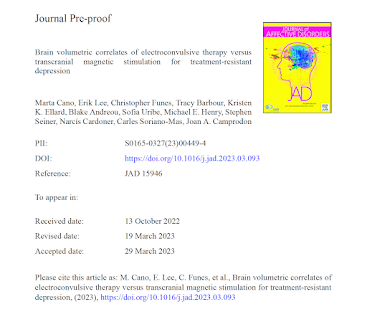ECT vs rTMS Structural Brain Changes: New Study in J Affective Disorders
Out on PubMed, from investigators in Boston and Barcelona, is this study:
J Affect Disord. 2023 Apr 4:S0165-0327(23)00449-4. doi: 10.1016/j.jad.2023.03.093. Online ahead of print.
PMID: 37024015

The abstract is copied below:
Background: Electroconvulsive therapy (ECT) and repetitive transcranial magnetic stimulation (rTMS) are effective neuromodulation therapies for treatment-resistant depression (TRD). While ECT is generally considered the most effective antidepressant, rTMS is less invasive, better tolerated and leads to more durable therapeutic benefits. Both interventions are established device antidepressants, but it remains unknown if they share a common mechanism of action. Here we aimed to compare the brain volumetric changes in patients with TRD after right unilateral (RUL) ECT versus left dorsolateral prefrontal cortex (lDLPFC) rTMS.Methods: We assessed 32 patients with TRD before the first treatment session and after treatment completion using structural magnetic resonance imaging. Fifteen patients were treated with RUL ECT and seventeen patients received lDLPFC rTMS.
Results: Patients receiving RUL ECT, in comparison with patients treated with lDLPFC rTMS, showed a greater volumetric increase in the right striatum, pallidum, medial temporal lobe, anterior insular cortex, anterior midbrain, and subgenual anterior cingulate cortex. However, ECT- or rTMS-induced brain volumetric changes were not associated with the clinical improvement.
Limitations: We evaluated a modest sample size with concurrent pharmacological treatment and without neuromodulation therapies randomization.
Conclusions: Our findings suggest that despite comparable clinical outcomes, only RUL ECT is associated with structural change, while rTMS is not. We hypothesize that structural neuroplasticity and/or neuroinflammation may explain the larger structural changes observed after ECT, whereas neurophysiological plasticity may underlie the rTMS effects. More broadly, our results support the notion that there are multiple therapeutic strategies to move patients from depression to euthymia.
Keywords: Electroconvulsive therapy; Structural magnetic resonance imaging; Transcranial magnetic stimulation; Treatment-resistant depression.
The article is here.
And from the text:
No surprise that ECT induces more powerful structural brain changes than rTMS, even RUL ECT, as in this comparison. This paper is heavily biased towards rTMS, stating multiple times its equivalency to ECT. The senior author has been a consultant to Neuronetics.





Comments
Post a Comment